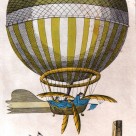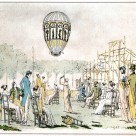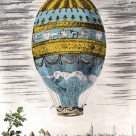Ballooning History
September 19, 1783 - A sheep, a duck, and a rooster become the first passengers in a hot air balloon launched by the Montgolfier brothers, Joseph and Ettienne.
November 21,1783 - The first recorded manned flight in a hot air balloon took place in Paris. Built from paper and silk by the Montgolfier brothers, this balloon was piloted on a 22 minute flight by two noblemen from the court of Louis XVI and Marie Antoinette. From the center of Paris they ascended 500 feet above the roof tops before eventually landing miles away in the vineyards. Local farmers were very suspicious of this fiery dragon descending from the sky. The pilots offered champagne to placate them and to celebrate the first human flight, a tradition carried on to this day.
Declared the sport of the Gods by Marie Antoinette, ballooning, in particular gas ballooning, became a popular pastime throughout Britain and Europe.
January 19, 1784 - In Lyon, France, the only recorded flight by Joseph Montgolfier was made in one of the largest balloons ever made.
September 15, 1784 - An Italian, Vincenzo Lunardi, made the first balloon flight outside of France. The 500 cubic metre balloon flew from Moorfields in England and landed near Ware.
November 30, 1784 - Launching their balloon from Rhedarium Garden, London, another Frenchman, Jean-Pierre Blanchard, and an American, John Jeffries, make their first flight.
January 7, 1785 - the same team of Jean-Pierre Blanchard and John Jeffries became the first to fly across the English Channel.
January 9, 1793 - the first flight of a balloon in North America occurred in Philadelphia and was piloted by Jean-Pierre Blanchard.
October 10, 1960 - the official birth date of the modern hot-air balloon. The first man-carrying free flight took place at Bruning, Nebraska, in the Raven prototype ‘modern' hot-air balloon. The 30,000 cu ft envelope was constructed of a polyurethane coated nylon and the burner was propane powered.
By 1963, the growing sport was able to sustain the first U.S. national championships.
The balloons used for passenger flights today were developed in the United States during the 1960s and have two main technological advances: using rip-stop nylon, a very safe and reliable material for the envelope and running a LPG gas burner to heat the air in the envelope. Ballooning began as a sport with a few enthusiasts in the USA and England and spread to Australia in the 1970s. Today there are over 5,000 balloon pilots in the U.S. alone.
The balloon you will see in the demonstration is an Australian built Kavanagh E140, the figure represents the volume in thousands of cubic feet, ie 140,000 cubic feet or 3,967 cubic metres. This balloon can carry six passengers plus a pilot.
The air in the balloon weighs just over 5 tonnes and when it is heated the air expands and becomes lighter, the excess air is expelled from the bottom of the balloon. Once the air is heated to approximately 75*C the balloon will be about 1 tonne lighter and will lift off.
The LPG burners each produce about 4500kw of heat and enough fuel is carried to fly for about 2 hours.
It is not possible to steer a balloon directly but if it is maneuvered up or down the pilot can fly it in different directions using the currents at different altitudes.


